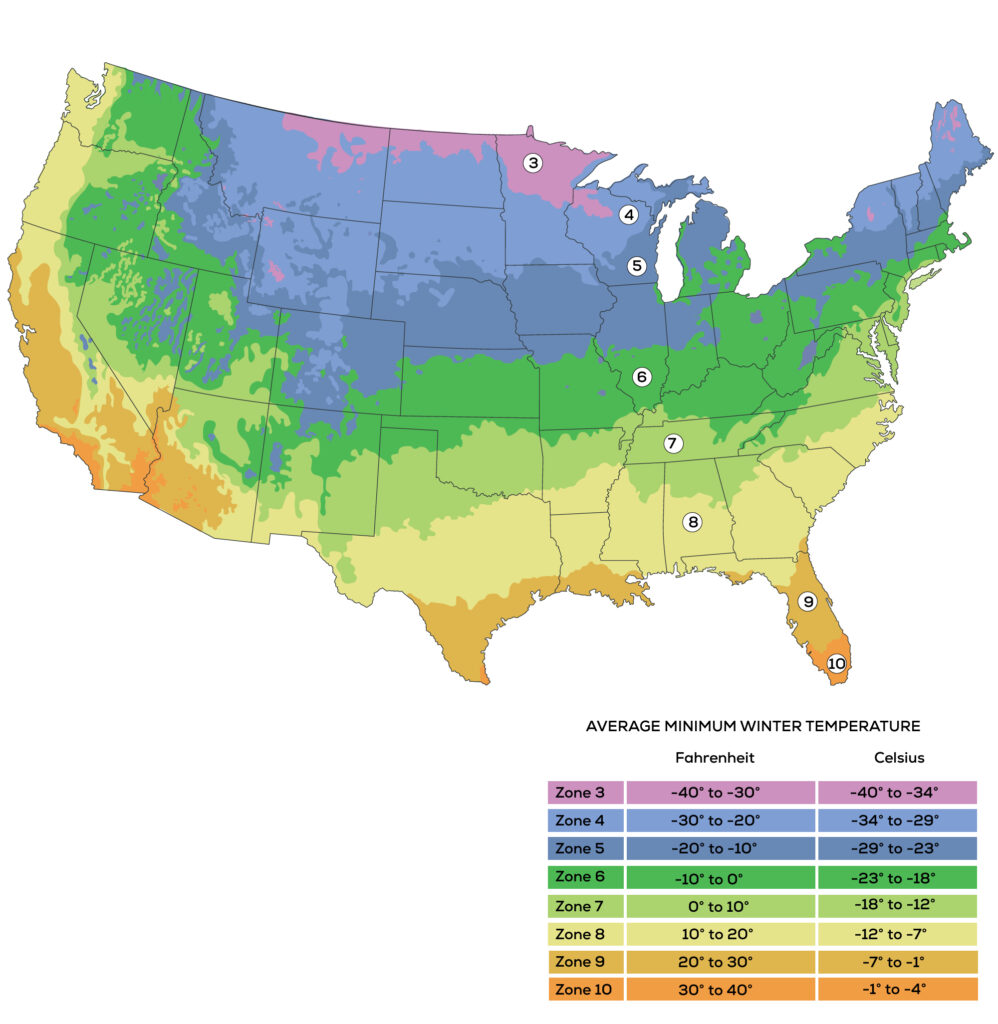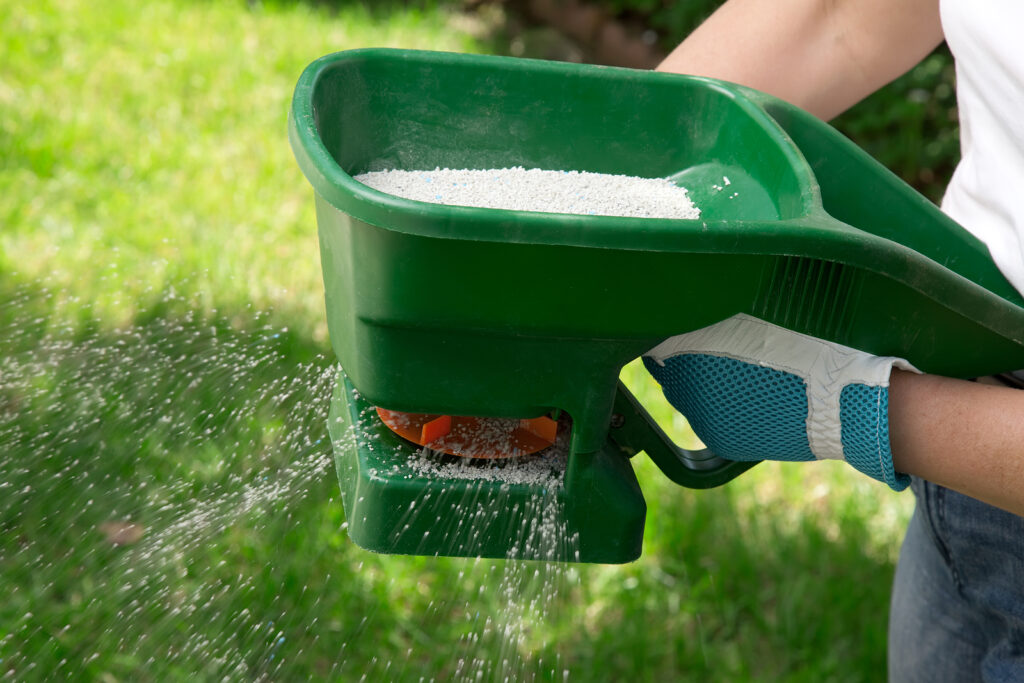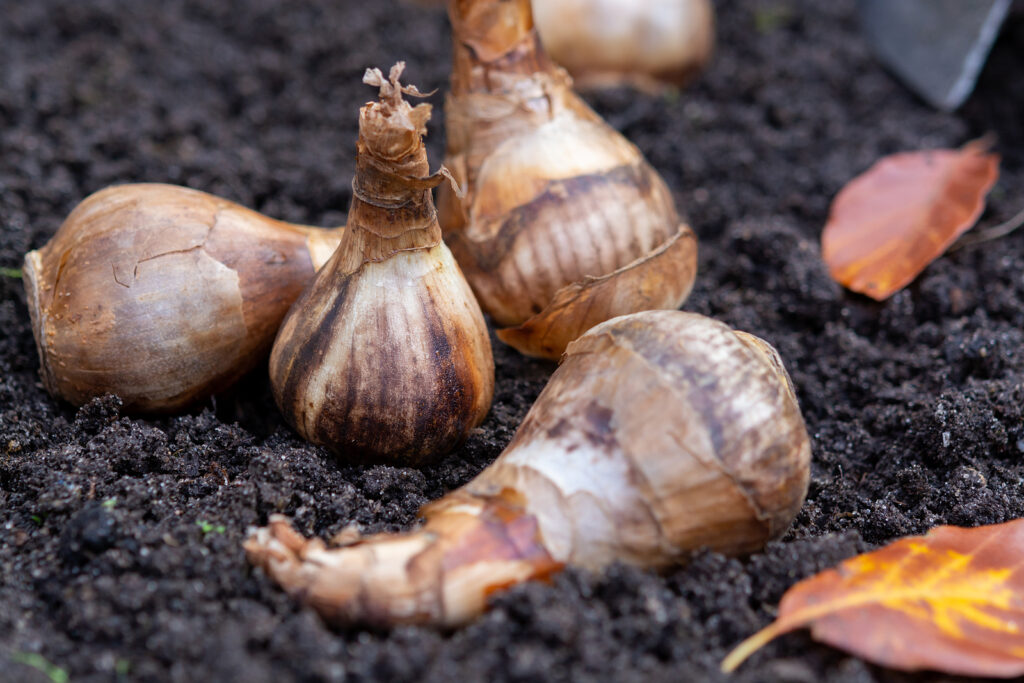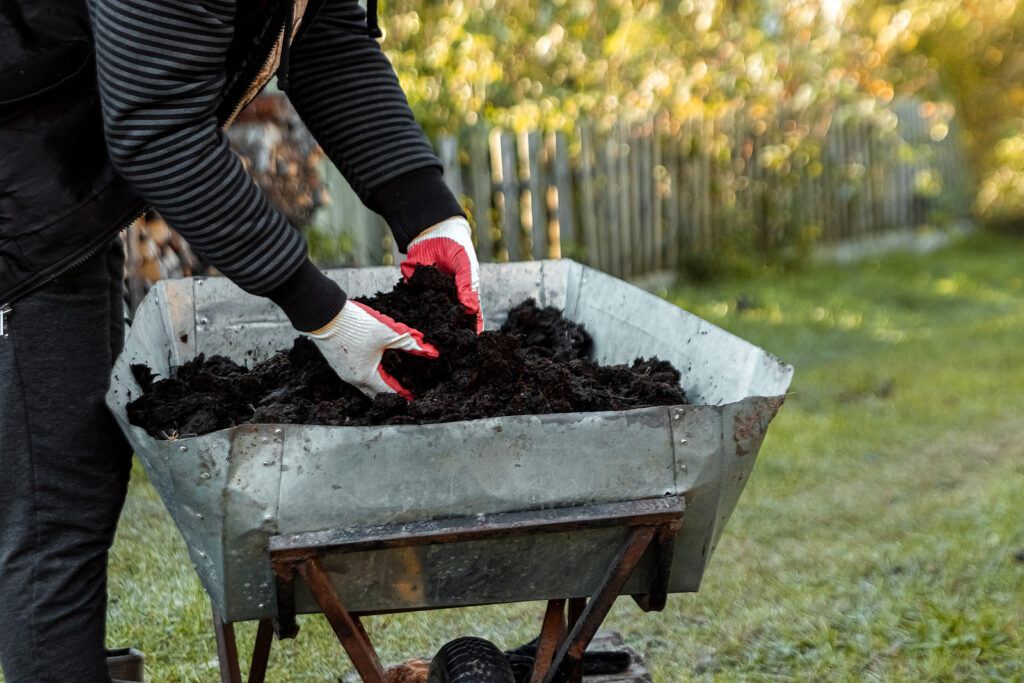The weather will direct your efforts in the garden in September — early autumn. While the first day of autumn will arrive on September 22, this month may seem like an extension of summer in many southern gardens. The first cold weather and even frost can come this month in northern gardens. Now is the time to look ahead to the first expected frost and mark it on your calendar. It may come this month in northern regions and can be a month or two off in southern regions, but it’s important to know when.
If you are unsure when the last frost in spring happens where you live–and when the first frost in autumn comes. Go to this post: Average Last and First Frost Dates for Cities, States, and Countries. The months between the last frost in spring and the first frost in autumn is the natural growing season for your region.

Zones 9 to 11 have 6 to 8 weeks or more of prime garden time to come. Zones 3 to 7 have four to 6 weeks of growing time left this year.
Here are our zone-by-sone garden tips for September. Find your zone on the map above and see our tips below.
Tips for Zones 9-11:
General Tasks: Water all plants regularly, giving priority to newly planted plants and those that are intolerant of drought. Keep the garden free of weeds. Remove and compost spent plants that are not infested with insect pests or infected with diseases. Prepare planting beds for autumn and spring planting. Add aged compost to planting beds.
Trees: Remove trees that are weak or rotted. Prune weak and damaged growth. Rake leaves and put them in the compost. Prepare planting holes for trees. Transplant deciduous trees. Plant palm trees. Water trees deeply in dry weather. Fertilize palm trees. Watch for pests and signs of disease. Take cuttings from evergreens for propagation.
Shrubs: Prune shrubs. Prune weak and damaged growth. Trim hedges. Divide multi-stemmed shrubs and vines. Remove dead blooms from summer bloomers as well as camellias. Clip hedges. Prepare planting holes for shrubs and vines. Transplant shrubs. Plant container-grown shrubs. Water shrubs deeply in dry weather, especially newly planted shrubs. Weed soil around shrubs. Mulch tender surface roots. Feed camellias with acid fertilizer; feed other winter bloomers. Withhold fertilizer and heavy watering from hibiscus, tibouchina, and other tender shrubs if a frost comes to your area in a month or two. Watch for pests and signs of disease. Propagate conifers and evergreens from stem cuttings. Take semi-ripe cuttings of berberis, camellia, ceanothus, cotoneaster, daphne, and mahonia.

Roses: Discontinue deadheading in mid-autumn. Pick up fallen leaves. Prune lightly to force November bloom; feed now for the last time this season. Prune rambler roses once flowering is over. Stake and tie climbing roses. Prepare planting holes for new roses. Plant container-grown roses. Continue to weed, water, and fertilize established plants. Apply granular fertilizer until early September. Watch for pests and signs of disease. Continue spraying regularly with a fungicide. Sweep up leaves to control diseases. Order roses for late-fall planting.
Lawns and Ground Covers: Mow and edge the lawn weekly or as needed except in very hot, dry weather. Trim back herbaceous plants that have grown over lawn edges. Sow or lay sod for cool-season lawn grasses. Over plant Bermuda grass or other summer grass lawns with annual ryegrass and keep constantly moist until germination. Keep new lawns moist; water established lawns as needed. Aerate the lawn if not done in spring; de-thatch if necessary. Water as needed. Fertilize established lawns or top-dress with compost. Fertilize with relatively high phosphate and potassium levels to encourage the development of strong roots. Prune ground covers. Divide ground covers and perennial ornamental grasses. Plant ground covers and perennial ornamental grasses. Apply a slow-release fertilizer on newly planted ground covers and ornamental grasses. Take ground cover stem cuttings for propagation.
Perennials: Continue to deadhead all flowering perennials, unless you intend to save seed. Cut flowers for fresh use or drying. Remove faded flowers. Compost spent plant materials. Prepare soil for fall planting. Cut back earlier bloomers when top growth begins to die back. Prune poinsettias for holiday bloom. Divide and transplant spring-flowering perennials. Thin and transplant perennials sown last month. Sow perennial and biennial seeds outdoors. Plant poppies and peonies. Move semi-hardy young plants to a cold frame. Water if the ground is dry and if leaves are wilted. Water newly planted plants and those that are intolerant of drought. Weed as needed. Apply slow-acting fertilizer to perennial beds. Fertilize tropical plants and late bloomers. Watch for pests and signs of disease. Take cuttings to start new plants. Take fuchsia and pelargonium cuttings. Move tender plants to a cold frame if frost is forecast.
Bulbs: Deadhead faded flowers. Cut lilies back to the ground after stalks die back. Check stakes on tall dahlias and gladiolus. Divide and replant spring-flowering perennials—iris, peony, Oriental poppy. Prepare soil for planting. Plant autumn-blooming bulbs; plant tender spring bloomers; plant lilies. Order hardy bulbs for fall planting; store them in the refrigerator until planting time. Plant amaryllis, autumn crocus, colchicum, fritillaria, lilium, and sternbergia bulbs to flower in late autumn. Plant paperwhite narcissus and other tender bulbs for early spring bloom. Protect newly planted bulbs from squirrels, birds, and other pests. Fertilize hardy summer flowering and other established bulbs. Watch for pests and signs of disease. Take stem cuttings from achimenes, tuberous begonias, and dahlias for propagation.
Annuals: Cut flowers for indoor displays. Cut flowers for drying. Continue to deadhead all flowering plants, unless you intend to save seed. Remove faded flowers. Pinch back tall-growing plants. Pull up annuals when plants are fatigued. Clean up empty beds and borders. Condition soil of flower beds using aged compost. Direct-sow hardy annuals for winter flowers next spring. Sow sweet peas. Sow pansies and other cool-season annuals in the garden or cold frame. Weed flower beds. Fertilize plants that are still in bloom. Fertilize plants with a slow-release high phosphorus fertilizer to flower beds. Watch for pests and signs of disease. Place snail and slug bait and protect seedlings from birds. Combat pests and fungal diseases using organic means, applying insecticides and fungicides only if necessary. Take cuttings of coleus, geraniums, and other annuals to pot up for winter houseplants.
Container Gardens: Continue to deadhead, water, and fertilize container plants. Harvest vegetables and herbs, cut flowers from containers. Sow hardy annuals in containers. Pot hardy bulbs at two-week intervals.

Tips for Zones 5-8:
General Tasks: Keep in mind frost may strike even in the mildest areas before the end of September. Keep an eye on local weather forecasts. Prepare soil for autumn or spring planting. Water all plants regularly, giving priority to newly planted plants and those that are particularly intolerant of drought. Rake autumn leaves regularly. Keep paths and drives weed-free by hand or with an organic weed killer. Clean up empty areas of the garden. Turn the compost pile or build a new pile if needed. If you have no cold frame, build one now.
Trees: Rake leaves and add them to the compost. Remove trees that are weak or rotted. Prune weak and damaged growth from trees. Transplant deciduous trees. Plant container and balled-and-burlapped deciduous trees. Water trees deeply in dry weather. Watch for pests and signs of disease. Take hardwood cuttings for propagation. Prepare planting holes for autumn planting trees, shrubs, and vines. Evergreens can be transplanted from now until the ground freezes. Fertilize tender trees and shrubs. Don’t fertilize deciduous trees after the middle of the month to prevent soft new growth which may be injured by frost. Withhold water also. Take hardwood cuttings of woody plants for rooting. Take cuttings from evergreens.
Shrubs: Prune weak and damaged growth from large shrubs. Divide multi-stemmed shrubs. Divide suckering shrubs such as philadelphus, thinning out the top growth to aid establishment. Give established hedging plants a final trim. Clip beech, holly, hornbeam, and yew hedges, and most evergreen hedges. Check supports and ties for shrubs and climbers after first autumn winds. Prepare the ground for planting evergreen and deciduous shrubs, digging in well-rotted manure or garden compost, with a sprinkle of bone meal. Prepare sites for new hedges. Prepare planting holes for shrubs and vines. Transplant evergreens. Transplant rhododendrons and azaleas if necessary. Plant container, balled, and bare-root shrubs. At the end of the month, start planting evergreens, preferably during wet weather. Train and tie vines if needed. Water plants deeply in dry weather. Remove weeds around shrubs. Mulch shrubs and climbers with weed-free organic matter. Fertilize tender shrubs. Feed camellias and winter-blooming shrubs that have not bloomed. Remove dead flowers from those that have. By the middle of the month, apply final fertilizer to plants; withholding fertilizer after the middle of the month will prepare plants for dormancy and prevent soft new growth which can be injured by frost. Withhold water also. Watch for pests and signs of disease. Continue to take semi-ripe cuttings of shrubs. Take hardwood cutting of deciduous and evergreen shrubs and root them in a sheltered place outside, in pots in a cold frame, or in a sheltered nursery bed. Take semi-ripe cuttings of berberis, camellia, ceanothus, cotoneaster, daphne, and mahonia. Layer branches of rhododendrons. Propagate conifers from stem cuttings.
Roses: Deadhead roses until early October.Prune roses lightly. Prune non-repeat-flowering ramblers and climbers, cutting back flowered shoots to ground level; tie in replacement shoots. Prune weeping standards, cutting back flowered shoots to the main stem. Check ties on standard roses. Their large heads can be damaged by autumn winds. Tie in shoots on climbers, training long shoots horizontally to encourage the production of flower-bearing side shoots. Pick up fallen leaves. Prepare the soil for new plantings, turning the soil and adding plenty of well-rotted manure or garden compost. Plant container-grown roses. Feed roses for the last time early this month. Feed bushes and climbers with sulfate of potash to harden new wood.Fertilizer should be withheld from roses after the middle of month to prevent soft new growth which may be injured by frost. Withhold water also. Watch for pests and signs of disease. Sweep up leaves to control diseases. Continue spraying regularly with a fungicide. Spray roses against fungal attacks such as powdery mildew, rust, and blackspot. Continue to spray to protect against mildew. Order roses for late-fall planting. Take hardwood cuttings for propagation in October. Take cuttings, up to 12 inches long of ripe side shoot on ramblers, climbers, and vigorous cluster-flowered (floribunda) roses. Root cuttings in a shaded outdoor bed.

Lawns and Ground Covers: Mow grass weekly or as needed. Continue to mow, raising the mower blades for a lighter cut. Mow high in dry areas. Rake fallen leaves off the grass as soon as possible, especially if the weather is wet. Thatch and aerate the lawn if needed. Sow lawn seed on prepared soil. Lay sod or plant plugs, water well, and ensure that they never dry out. Reseed worn and damaged patches on the lawn. Water new plantings regularly, established lawns as needed. Improve drainage where necessary by forking deeply or using a hollow-tined fork. Fill the holes by brushing in sharp sand or a light commercial planting mix. Aerate the lawn to encourage good drainage and stimulate root growth. Use a garden fork for small areas or a powered aerator for large areas. Apply an autumn fertilizer. Fertilize the lawn for the second time if three yearly applications are needed. Apply a lawn fertilizer with relatively high phosphate and potassium levels to encourage the development of strong roots. Continue to treat weeds and moss on the lawn. Trim back herbaceous plants that have grown over the lawn edges. Prune ground covers. Divide ground covers and perennial ornamental grasses. Plant ground covers and perennial ornamental grasses. Water as needed. Continue to water regularly and thoroughly during hot, dry weather. Apply a slow-release fertilizer on newly planted ground covers and ornamental grasses. Always water well after applying any kind of fertilizer. Apply an insecticide drench if Japanese beetle grubs are present in the lawn.
Perennials: Remove spent blooms. Cut back earlier bloomers when top growth begins to die back. Remove dead and dying herbaceous plants, leaving enough foliage behind to protect the crown from cold winter weather. Disbud chrysanthemums as necessary. Divide and transplant spring-flowering perennials. Make sure that summer-flowering perennials are staked if necessary. Compost spent plant materials. Plant perennials for next year. Set out young perennial plants in permanent locations. Plant out hardy biennials. Plant rooted cuttings of pinks. Sow perennial and biennial seeds outdoors. Water new plantings regularly; established plants as needed. Chrysanthemums and hardy asters should be fed every two weeks until buds show color and should be kept well-watered. Mulch around young perennials after planting with light. Weed beds and borders regularly. Fertilize late-blooming perennials; feed mums for the last time just before buds open. Apply slow-acting fertilizer to perennial beds. Watch for pests and signs of disease. Control earwigs and powdery mildew on chrysanthemums. Take fuchsia and pelargonium cuttings. Layer border carnations. Prepare soil for fall planting. Install wind and soil erosion controls.
Bulbs: Deadhead faded flowers. Cut lilies back to the ground when stalks die back. Lift and store dahlias after the first frost. Lift and store gladioli and other tender bulbs, corms, and tubers. Dig, divide and replant peonies and other early-blooming perennials such as daylilies, iris, and Oriental poppies. Discard diseased, dug-up bulbs. Check stakes on tall dahlias and gladiolus. Order hardy bulbs for fall planting; store them in the refrigerator until planting time. Prepare soil for later planting. Pot up bulbs for forcing. Plant autumn-blooming bulbs; plant amaryllis, autumn crocus, colchicum, fritillaria, lilies, and Sternbergia bulbs. Plant bulbous irises, peonies, and poppies. Remove bulbils from Lilium auratum; pot up and place them in a cold frame. Protect newly planted bulbs from squirrels, birds, and other pests. Dig and store tender bulbs in a cool, dry location. Water if necessary. Apply mulch for winter. Fertilize hardy summer flowering and other established bulbs. Feed dahlias every two weeks. Feed amaryllis and other established bulb plantings with one-teaspoon muriate of potash to ½ gallon of water, to harden for cold weather. Watch for pests and signs of disease. Take stem cuttings from achimenes, tuberous begonias, and dahlias for propagation. Order bulbs catalogs and bulbs for autumn delivery. Start planting spring-flowering bulbs. Plant daffodils, hyacinths, crocuses, scillas, iris, and most lilies for a spring blooming. Plant tulips last. Lift bulbs, corms, and tubers of summer-flowering tender bulb plants before or just after the first frost; dry them and store them.

Annuals: Cut flowers for indoor displays. Cut flowers for drying. Continue to deadhead all flowering plants unless you intend to save seed. Pinch back tall-growing plants. Cut back exhausted annuals severely, to encourage new growth. Pull up annuals when plants become fatigued or are killed by frost. Remove the remains of summer-flowering annuals and prepare the soil thoroughly for winter-flowering bedding plants. Condition the soil in flower beds adding aged manure and compost. Set outdoors winter-blooming flower plants. Sow hardy annuals to overwinter. Hardy annuals include alyssum, bachelor’s buttons, calendula, candytuft, cornflowers, larkspurs, love-in-a-mist, pansies, pot marigolds, poppies, and snapdragons. Fertilize plants still in bloom with a slow-release fertilizer high in phosphorus. Combat pests and fungal diseases using organic means, applying insecticides and fungicides only if necessary. Place snail and slug bait and protect seedlings from birds. Take cuttings of coleus, geraniums, and other annuals to pot up for winter houseplants.
Container Gardens: Continue to cut flowers and deadhead container plants. Continue to remove annuals as they die off. Plant spring bulbs in containers. Set dwarf varieties round permanent plantings of shrubs or in window boxes with pansies; larger varieties are best planted in pots of their own. Plant window boxes with spring bedding, such as forget-me-nots, primulas, and wallflowers. Plant hanging baskets for winter and spring using a mixture of dwarf evergreens, such as ivies, bedding plants such as pansies, and primulas and early bulbs. Lift a few herbs, such as chives and parsley, to grow in a container in a sheltered place for a winter and spring supply. Continue to water plants during dry weather. Feed plants in containers to keep the blooms coming. Empty containers of plant material if you are not growing in containers this winter.
Rock garden: Lift and divide and replant alpines such as globularias, mertensias, omphalodes, and veronicas. Transplant alpines that have outgrown their spaces. Take basal cuttings of viola species and root them in a cold frame.
Water garden: Feed fish sparingly, using high-protein fish emulsion. Clear and tidy the bog garden. Plant out bog primulas raised from seed. Collect winter-resting buds of bladderwort and frogbit before they sink to the pond bottom; keep them in a large jar of pond water on a cold window ledge until spring. Take indoors tender aquatic plants if frost is forecast. Place nets over the pond to prevent water from becoming polluted by falling leave.
Greenhouse: Keep watch for pests and disease. Continue to feed pot plants regularly. Pot on and pot up seedlings as they become necessary. Sow spring-flowering plants such as cyclamen, schizanthus, and exacums. Take leaf and semi-ripe cuttings. Take cuttings of ivy-leaved and zonal pelargoniums and pot them up. Plant hyacinths for early flowering under glass. Check cinerarias for leaf miners (white ‘tunnels’ in leaves). Remove affected leaves or control with a systemic insecticide. Check heaters to be sure they are working. Remove shading from the greenhouse glass. Bring in house and greenhouse plants that have been outdoors for the summer.
Indoors: Bring houseplants indoors if they have been outdoors through the summer; tender plants will be injured by the slightest frost. Repot plants as necessary. Place in north or west windows ferns, ivies, tolmieas, philodendrons, trandescantias, and also large-leaved begonias. Place flowering plants in south or east windows; African violets do best in east or west exposures. Feed Christmas cactus every two weeks. Water houseplants moderately. Watch for aphids and other pests and treat them at once. Weekly syringing of leaves with water will discourage pests. Withhold plant food withheld until new growth starts.

Tips for Zones 2-4
General Tasks: Frost may strike at any time before the end of this month. Monitor local weather forecasts and plan garden activities accordingly. Collect and compost fallen leaves. Remove fallen leaves from gutters. Compost is an important soil additive. Build a new compost heap you don’t have one. Continue to remove the last of the weeds taking care not to spread seeds. Prepare soil for autumn or spring planting. Condition the soil in flower beds adding compost and aged manure. Apply phosphorus source to the soil in flower beds. Protect vulnerable plants that will remain in the garden. Water as needed. Check and repair trellises and raised beds. Repair and paint trellises, arbors, fences, benches, and garden accessories. Turn off water and drain hoses before the first freeze.
Trees: Water trees if the ground is dry. Rake leaves and put them in the compost. Transplant deciduous shrubs and trees. Transplant trees and shrubs while the soil is still warm and moist, but not too wet. Plant bare-root and balled-and-burlapped trees and shrubs. Apply winter mulch around trees and wrap the trunks of vulnerable trees in burlap. Set up windbreaks for young trees in windy locations. Stake young trees to hold them in place during winter storms. Remove any trees that are weak or rotted.
Shrubs: Transplant deciduous shrubs. Evergreens can be planted now until the ground freezes. Plant and transplant shrubs while the soil is still warm and moist, but not too wet. Prune evergreen and deciduous shrubs and hedges and carry out any necessary major cutting back. Divide multi-stemmed shrubs. Take hardwood shrub cuttings. Take semi-ripe cuttings. Propagate conifers from stem cuttings. Sow seeds of woody plants needing stratification outdoors. Protect vulnerable shrubs that will remain in the garden. Spray broad-leaved evergreens with antidessicant. Apply mulch for winter and install burlap screens. Stop fertilizing shrubs to encourage dormancy. Water new and established shrubs deeply if the weather is dry to prepare for winter. Stake young shrubs to hold them in place during winter storms.
Roses: Water roses if the weather is dry. Discontinue watering next month. Clip off new growth that has not yet hardened. Prune back rambler roses once flowering is finished. Stop pruning roses by the middle of the month. Pruning can trigger new growth which will be susceptible to frost damage. Plant roses. Mound soil around the base of roses for winter protection. Spray roses against fungal attack such as powdery mildew, rust, and blackspot. Watch out for pests and diseases on roses and other vulnerable plans. Install windbreaks and winter protection if needed.
Lawns and Groundcovers: Rake and remove autumn leaves from the lawn. Use them to make leaf mold for mulching next spring. Sow grass seed; lay sod; plant plugs. Mow and edge the lawn as needed. Thatch and aerate the lawn if needed; this removes any dead matter and debris from the surface. Apply a lawn fertilizer with relatively high phosphate and potassium levels to encourage the development of strong roots. Always water well after applying any kind of fertilizer. Water the lawn in dry spells, but a few good soaks will be better than many sprinklings that do not penetrate deeply. Repair any humps and in the lawn created by excessive summer wear and tear. Continue to cut back herbaceous plants that have flopped over the lawn edges. Clean the lawnmower and do any necessary repairs before storing it for the winter. Repair broken and crushed lawn edges. Plant groundcover shrubs and perennials while the soil is still warm. Apply a slow-release fertilizer to newly planted groundcovers.

Perennials: Plant spring-flowering plants for added color to fill any gaps between shrubs next spring. Apply slow-acting fertilizer to perennial beds. Protect the crown of vulnerable herbaceous plants such as delphiniums and lupines from slugs by springing coarse grit around them. To ensure good bud formation for plenty of spring flowers, provide all plants with enough water during dry spells. Divide and replant early blooming perennials. Lift and take in perennials not hardy enough to overwinter outside. Take into the greenhouse or indoors tender fuchsias and pelargoniums. Cut down the dead tops of herbaceous perennials that will overwinter in the garden. Apply winter mulch to perennial beds after the first hard freeze. Sow seeds of woody plants and perennials needing stratification outdoors. Collect seeds from selected flower heads.
Bulbs: Dig up dahlias, gladioli, and other tender bulbs and dry and store them. Plant spring-flowering bulbs—crocus, daffodils, narcissus, and lily-of-the-valley. Plant tulip bulbs last, preferably in a sunny sheltered border or in containers.
Annuals: Continue to deadhead all flowering plants unless you intend to save seed. Cut flowers for indoor displays. Cut flowers for drying. Remove annuals that are fatigued or killed by frost. Clear spent summer bedding. Start sowing hardy annuals to overwinter–only in mild areas or if you can provide winter protection.
Container Gardens: Feed plants in containers to keep them blooming. Remove spent plants and plants killed by frost and add them to the compost. Do not compost diseased plants. Clean and disinfect pots to be stored over the winter.
Rock Gardens: Remove leaves that have fallen on rock plants. Cover alpines that need protection from winter.
Water Garden: Prepare the pond for winter. Remove pumps from the pond and store them for the winter.
Greenhouse: Water overwintering plants occasionally so that they do not dry out completely. Except with winter-flowering plants that are still in strong active growth, gradually give plants less water. Most will then tolerate low temperatures better and disease should be less of a problem. Lift crowns of lily-of-the-valley, and pot them up for an early, indoor, scented display. Clean and disinfect the greenhouse and get it ready for winter. Check insulation. Monitor the temperature. Ventilate the greenhouse whenever the weather is mild enough. If you do not have a cold frame, build one now.
Indoors: Bring indoors houseplants and other tender plants before the first frost. Place in north or west windows, ferns, ivies, tolmieas, philodendrons, trandescantias, and large-leaved begonias; place flowering plants in the south or east windows; African violets do best in east or west exposures. Feed Christmas cactus every two weeks. Syringe plant leaves with water frequently; this will discourage insect pests. Water indoor plants moderately. Watch for aphids and other pests. Treat insects and diseases immediately. Houseplants that do not send out new growth, should be watered moderately, and plant food should be withheld until new growth starts. If portions of houseplants die back after bringing them indoors, prune back the dead branches to live wood. Start cuttings of tender, flowering houseplants.















